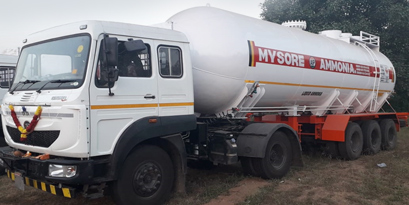Anhydrous Ammonia
Anhydrous Ammonia is a liquid when compressed and liquefied under high pressure and low temperature. Liquid Ammonia vaporizes as soon as it gains adequate temperature and/or exposure to the atmosphere.
It has a strong and pungent odour; so much so that, even at a miniscule level of exposure its presence can be detected even though it is a colourless gas by its characteristic smell. This property of Ammonia is its biggest safety feature.
The chemical formula of Ammonia is NH 3 with UN No. 1005 and CAS registry 7664-41-7. Ammonia is a versatile chemical and therefore has a wide range of applications across Industries. As a basic chemical several Industries like Rubber, Pharmaceuticals, Chemicals, and Refrigeration among others use Anhydrous Ammonia in its liquid, and/or gaseous state.
At temperatures over 450ºC, Ammonia decomposes to liberate Hydrogen and Nitrogen gases though it may decompose at lower temperatures in the presence of appropriate catalysts.
Liquefied Ammonia is supplied in steel containers of varying capacity ranging from 40 to 60 kg Cylinders, 400 kg Tonners, 6 to 15 MT Tankers and ISO Tanks. All of these packaging units with capability to withstand higher pressures are compliant with necessary statutory requirements of the Petroleum and Explosives Safety Organization and the International Maritime Organization as applicable.
In an open and well ventilated area, Ammonia is generally not a fire hazard while in a closed and confined area Ammonia may be a fire hazard, especially if oil and other combustible materials are present.
Galvanized surfaces, aluminum alloys, brass, bronze, copper, gold and silver gets corroded on exposure to Ammonia Gas.


Anhydrous Ammonia - Specifications
Ammonia Anhydrous Product Specification: Both Commercial Grade Ammonia And Moisture Free Ammonia.
| Anhydrous Ammonia (Refrigerant Ammonia) | |
| Purity | 99.99 % |
| Oil (Max) | 10 PPM |
| Moisture (Max) | 0.01 % |
| Pyridine | Nil |
| Napthanlene | Nil |
| Phosphic | Passes Test |
| Sulphur Compounds | Passes Test |
| Anhydrous Ammonia | |
| Purity | 99.5 % |
| Oil (Max) | 0.02 % |
| Moisture (Max) | 0.5 % |
| Residue On Evaporation % By Valume | 0.05 % |
| Pyridine | Nil |
| Napthanlene | Nil |
| Phosphic | Passes Test |
| Sulphur Compounds | Passes Test |
Anhydrous Ammonia conforms to IS : 662 -1955
Anhydrous Ammonia - Safety Data
First Aid For Ammonia Exposure: (NH 3)
Preparing For Ammonia Emergency
-
Learn Ammonia First Aid Procedure
- Mouth to Mask Resuscitation
- Cardiopulmonary Resuscitation (CPR)
- Treatment for Shock.
- Be-Prepared –Delay And inexperience may result in a more serious injury.
-
Make sure your emergency Support is knowledgeable about ammonia first aid and treatment.
- Local fire Department/ Ambulance Service
- Emergency Clinic
- Local Hospital
- NEVER wear contact lenses when working with any chemical.
Overexposure to Ammonia Vapour
- Remove victim to fresh Air
- Summon An ambulance
- If breathing fails, start mouth /mask resuscitation
- If no pulse , begin CPR
- If patient goes into shock ,treat accordingly
- Oxygen may be administered by trained persons
Exposure to Liquid Ammonia - Eyes
- FLOOD IMMEDIATELY with water for at least 15 minutes. Eyelid must be held open during washing.
- Summon On Ambulance
- Determine If patients is wearing contact lenses and advise medical personnel
Exposure to Liquid Ammonia – Skin
- FLOOD IMMEDIATELY with water for at least 15 minutes.
- Summon On Ambulance
- Decontaminate the victim with water before transporting in the close confines of an ambulance
-
Flood Clothing with large quantities of water
CAUTION – Skin may be frozen to clothing. Decision to remove clothing should be made by medical personnel only - Advise medical personnel that burns are from ammonia and salves or ointments should not be applied
Anhydrous Ammonia - Applications
-

Rubber
-

Leather
-

Plastics
-

Electronics
-

Power &
Energy -

Food &
Beverage -

Mining &
Metallurgy -

Pulp &
Paper -

Industrial
Refrigeration -

Agriculture & Fertilizers
-

Water &
Waste Water
Treatment -

Chemicals,
Pharmaceuticals
& Biotechnology -

Steel Industry